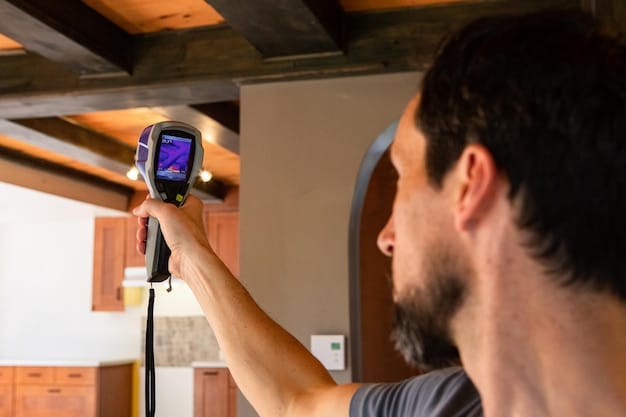Budgeting for Rising Energy Costs: UK Household Tips

Anúncios
Budgeting for rising energy costs involves implementing practical strategies such as energy audits, comparing tariffs, improving insulation, and adopting energy-efficient habits to mitigate the financial impact on UK households.
As energy prices continue to climb, UK households are feeling the pinch. Learning how to budget for rising energy costs: practical tips for UK households can significantly ease the financial burden and ensure you stay warm without breaking the bank.
Anúncios
Understanding the Energy Price Landscape in the UK
The UK’s energy market has seen considerable volatility in recent years. Understanding the factors that influence energy prices is crucial to effectively budgeting and managing your expenses.
Several elements impact the prices you pay for gas and electricity. These include global demand, geopolitical events, and regulatory changes.
Anúncios
Key Factors Influencing Energy Prices
Several factors contribute to the fluctuating energy prices in the UK. Understanding these elements can help you anticipate changes and plan accordingly.
- Global Demand: Increased demand from countries worldwide drives up prices.
- Geopolitical Events: Political instability and conflicts can disrupt supply chains, leading to higher costs.
- Regulatory Changes: Government policies and regulations can impact the costs of energy production and distribution.
Furthermore, the transition to renewable energy sources, while beneficial for the environment, can sometimes lead to short-term price increases due to infrastructure investments and technological advancements.
Conducting an Energy Audit for Your Home
Before you can create an effective budget, you need to understand how much energy your household consumes. An energy audit helps identify areas where you’re using too much energy and where you can make improvements.
An energy audit involves assessing your home’s energy efficiency, identifying areas of waste, and recommending solutions to reduce consumption.

DIY Energy Audit Steps
You can perform a basic energy audit yourself. Here are some simple steps to get you started:
- Check Insulation: Inspect your loft, walls, and floors for adequate insulation.
- Inspect Windows and Doors: Look for drafts and consider sealing gaps.
- Examine Appliances: Note the energy ratings and usage patterns of your appliances.
After conducting the audit, compile your findings and prioritize areas for improvement. Start with the most cost-effective solutions, such as sealing drafts and upgrading light bulbs.
Comparing Energy Tariffs and Suppliers
One of the most effective ways to budget for rising energy costs is to compare different energy tariffs and suppliers. The energy market is competitive, and switching suppliers can often lead to substantial savings.
Comparing tariffs involves evaluating different rates, contract lengths, and supplier reputations to find the best deal for your needs.
Tips for Comparing Tariffs
When comparing energy tariffs, consider the following:
- Fixed vs. Variable Rates: Fixed rates provide price stability, while variable rates fluctuate with market conditions.
- Contract Length: Longer contracts may offer lower rates but less flexibility.
- Supplier Reputation: Check customer reviews and ratings to ensure reliable service.
Use comparison websites to quickly assess multiple suppliers and tariffs. Be sure to read the fine print and understand any potential exit fees or hidden charges.
Improving Home Insulation
Effective insulation is key to minimizing heat loss and reducing your energy bills. Improving your home’s insulation can be a significant investment, but it pays off in the long run.
Insulation helps to maintain a consistent temperature inside your home, reducing the need for heating and cooling.

Types of Insulation
There are several types of insulation available, each with its own benefits:
- Loft Insulation: Reduces heat loss through the roof.
- Wall Insulation: Fills cavity walls to prevent heat from escaping.
- Floor Insulation: Reduces heat loss through the ground floor.
Assess your home’s insulation needs and choose the best options for your budget. Government grants and schemes may be available to help with the costs.
Adopting Energy-Efficient Habits
Even small changes in your daily habits can make a big difference in your energy consumption. Adopting energy-efficient habits can significantly lower your bills without requiring major investments.
Energy-efficient habits involve simple adjustments to your routine that reduce energy waste and promote conservation.
Simple Energy-Saving Habits
Here are some easy-to-implement habits to reduce your energy usage:
Turning off lights when leaving a room, unplugging chargers, using energy-efficient appliances, washing clothes in cold water and avoiding using the tumble dryer where possible can all save on energy consumption.
- Turn off Lights: Make sure lights are turned off when you leave a room.
- Unplug Chargers: Unplug electronic chargers when not in use.
- Use Energy-Efficient Appliances: Opt for appliances with high energy ratings.
- Wash Clothes in Cold Water: Cold water washing saves energy and is often just as effective.
By making these habits part of your daily routine, you can cumulatively save a considerable amount on your energy bills.
Utilising Smart Technology
Smart technology can help you monitor and control your energy usage more effectively. Smart thermostats, smart plugs, and energy monitors provide valuable insights and automation features.
Smart technology allows you to remotely manage your energy consumption, optimize settings, and identify areas of waste.
Smart Devices for Energy Efficiency
Consider investing in the following smart devices:
- Smart Thermostats: Can automatically adjust temperatures based on usage patterns.
- Smart Plugs: Allow you to remotely turn off appliances and monitor energy consumption.
- Energy Monitors: Provide real-time data on your energy usage.
These devices can provide data-driven insights that help you fine-tune your energy usage and reduce waste.
| Key Point | Brief Description |
|---|---|
| 💡 Energy Audit | Identify energy wastage areas in your home. |
| 💰 Tariff Comparison | Switch to cheaper energy suppliers for savings. |
| 🏠 Insulation | Improve insulation to reduce heat loss. |
| 🔌 Smart Tech | Use smart devices to monitor and control energy use. |
Frequently Asked Questions
▼
It’s a good practice to compare energy tariffs at least once a year. This ensures you’re always on a competitive rate and can take advantage of any new deals available in the market.
▼
The most common areas of heat loss include uninsulated lofts, cavity walls, and draughty windows and doors. Addressing these areas can significantly improve your home’s energy efficiency.
▼
Yes, the UK government offers various grants and schemes to help households improve their energy efficiency. Check the government website for the latest information and eligibility criteria.
▼
Smart thermostats learn your heating patterns and automatically adjust temperatures to optimize energy usage. They can also be controlled remotely, ensuring you’re not heating an empty home.
▼
Consult reputable sources such as energy efficiency websites, government resources, and consumer advice organisations. These sources provide evidence-based tips and guidance to help you save energy.
Conclusion
Budgeting for rising energy costs requires a multi-faceted approach, from conducting energy audits and comparing tariffs to improving insulation and adopting energy-efficient habits. By implementing these practical tips, UK households can effectively manage their energy consumption, reduce their bills and minimise the financial impact of rising energy prices.





